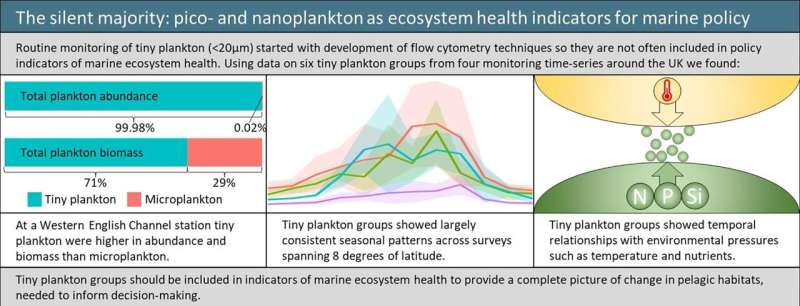This article has been reviewed according to Science X's editorial process and policies. Editors have highlighted the following attributes while ensuring the content's credibility:
fact-checked
trusted source
proofread
Small but mighty: Study highlights abundance and importance of the ocean's tiniest inhabitants

Tiny plankton—measuring less than 20 µm (or 0.02 mm) in diameter—make up the majority of plankton in the ocean and play a critical role in the planet's health, according to new research.
However, scientists say challenges in identifying them have led to them becoming a silent majority that is currently being overlooked when it comes to global ocean policy.
The study is one of the first to explore the abundance and importance of these tiny ocean inhabitants around the U.K. coastline, with the technology capable of monitoring them only having been introduced in around 2010.
However, that monitoring has shown that in some instances, 99.98% of plankton abundance—and 71% of plankton biomass—is derived from these tiny cells.
The research has also shown they can be impacted directly by changes in ocean temperatures and nutrients, in addition to other environmental shifts taking place as a result of climate change.
Published in the journal Ecological Indicators, the study, titled "The silent majority: pico- and nanoplankton as ecosystem health indicators for marine policy," involved a number of the U.K.'s leading plankton scientists and was carried out using cutting edge surveying and identification techniques.
"You hear of phrases like searching for a needle in a haystack, but this takes it to a whole new level. Identifying something that measures 0.02 mm in the ocean is an immense challenge, but an increasingly important one at a time of huge environmental pressures.
"These plankton may be tinier than most people can realistically imagine, but they underpin the entire marine food web and play a critical role in producing the oxygen our planet needs. We need to take this silent majority more seriously," says Abigail McQuatters-Gollop, associate professor of marine conservation and lead author on the study.
Larger plankton have been used for decades to monitor ecosystem productivity and biodiversity, but four U.K. plankton surveys—including the Marine Biological Association's Continuous Plankton Recorder survey—have also sampled tiny plankton in the past 14 years.
The researchers involved in the current study used the results of those surveys, which focused on the English Channel and Scottish coast, to investigate six groups of tiny plankton including two groups of heterotrophic bacteria.
Doing that involved a combination of flow cytometry—a laser-based technique used to detect and analyze the chemical and physical characteristics of cells or particles—and light microscopes.
This provided evidence of the abundance of tiny plankton, with that data then being cross-referenced against known changes in environmental conditions to assess how they were being impacted.
As a result, the researchers have recommended that tiny plankton groups should be used to inform biodiversity indicators that meet policy obligations under the EU Marine Strategy Framework Directive (MSFD), (Oslo-Paris Convention) OSPAR strategies, and the UK Marine Strategy.
They have also called for long-term monitoring of tiny plankton across multiple sites to ensure that policy decisions are based on accurate local and global evidence.
Study co-lead Dr. Rowena Stern, a CPR research fellow at the Marine Biological Association (MBA), added, "We have been able to connect these tiny plankton to meaningful indicators for policy use by measuring how human-driven environmental pressures affect the timing of their growth. This has only been possible by taking consistent, long-term measurements of these types of plankton."
More information: Abigail McQuatters-Gollop et al, The silent majority: Pico- and nanoplankton as ecosystem health indicators for marine policy, Ecological Indicators (2024). DOI: 10.1016/j.ecolind.2024.111650
Provided by University of Plymouth




















